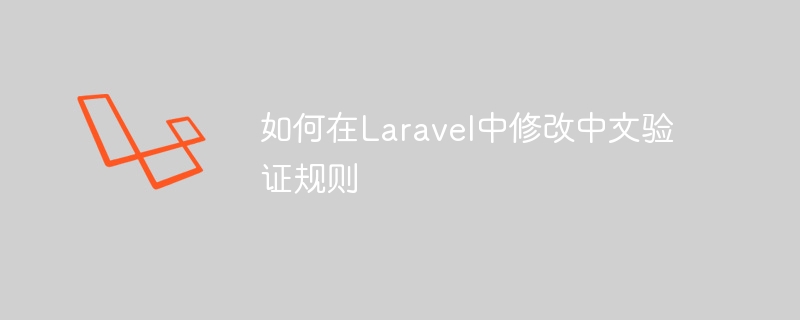

It is a very common requirement to modify Chinese validation rules in Laravel, especially when developing projects in a Chinese environment. By default, Laravel's validation rules are in English, but we can modify them to Chinese rules through a custom validator to make the code clearer and easier to understand. The specific steps, including code examples, are described below:
First, we need to create a custom validator , in order to define Chinese validation rules there. In Laravel, you can use the Artisan command to generate a custom validator:
php artisan make:validator CustomValidator
This will generate a CustomValidator.php file in the app/Validators directory, and we will define Chinese validation rules in this file.
In the CustomValidator.php file, we can define Chinese validation rules, for example:
namespace AppValidators;
use IlluminateValidationValidator;
class CustomValidator extends Validator
{
protected $customMessages = [
'required' => '必填项',
'email' => '邮箱格式不正确',
'numeric' => '必须为数字',
// 可根据需要添加更多中文验证规则
];
}Here, we use the $customMessages array to define Chinese validation rules, such as changing 'required' to 'required', 'email' to 'email format is incorrect', etc.
Next, we need to register the custom validator in the boot method of AppServiceProvider to let Laravel know about us To use this custom validator. In the AppServiceProvider.php file:
namespace AppProviders;
use IlluminateSupportServiceProvider;
use AppValidatorsCustomValidator;
class AppServiceProvider extends ServiceProvider
{
public function boot()
{
$this->app['validator']->resolver(function($translator, $data, $rules, $messages) {
return new CustomValidator($translator, $data, $rules, $messages);
});
}
public function register()
{
//
}
}This code registers the CustomValidator into Laravel so that the Chinese rules we defined can be used during validation.
Finally, we can use Chinese validation rules directly in controllers or form requests:
$request->validate([
'email' => 'required|email',
'password' => 'required|min:6',
], [
'email.required' => '邮箱为必填项',
'password.required' => '密码为必填项',
'password.min' => '密码长度不能少于6个字符',
]);Through the above steps, we have successfully modified the Chinese verification rules in Laravel. This can make the code more readable and understandable, and make development in a Chinese environment more convenient. Hope this helps!
The above is the detailed content of How to modify Chinese validation rules in Laravel. For more information, please follow other related articles on the PHP Chinese website!
 Introduction to laravel components
Introduction to laravel components
 Introduction to laravel middleware
Introduction to laravel middleware
 What are the design patterns used by laravel?
What are the design patterns used by laravel?
 Which one is easier, thinkphp or laravel?
Which one is easier, thinkphp or laravel?
 Laravel Tutorial
Laravel Tutorial
 How to clean the C drive when it turns red
How to clean the C drive when it turns red
 How to use redis as a cache server
How to use redis as a cache server
 minidump blue screen
minidump blue screen
 Introduction to foreign free vps software
Introduction to foreign free vps software




